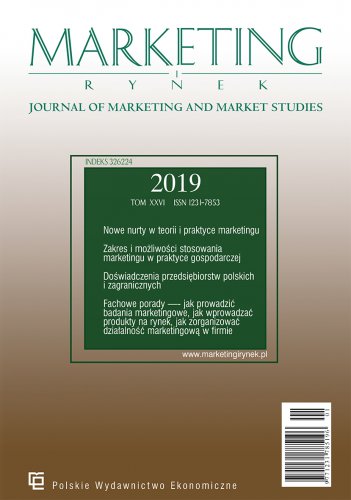Nowoczesne metody badawcze w obszarze customer experience
Badania customer experience stanowią ważny punkt oferty każdej liczącej się agencji badawczej. Głównym celem artykułu jest pokazanie obszarów kluczowych z punktu widzenia CX i rodzajów badań w nich prowadzonych. Dodatkowo przedstawione zostały dwa najnowsze narzędzia do badania customer experience rozwijane przez agencję badawczą Kantar: oparte na grywalizacji jakościowe „Nasze Miasto” oraz ilościowe CX+. Opisano założenia stojące za obydwoma narzędziami i wskazano obszary zastosowań wraz z zaznaczeniem ich unikalnego wkładu w procesy badania CX.
Bibliografia
Anderson, E.W. & Mittal, V. (2000). Strengthening the satisfaction profit chain. Journal of Service Research, 3(2), 107–120. https://doi.org/10.1177/109467050032001
Becker, S., Goldstein, D., & Sweeney, T. (2013). Does a gamified approach provide greater insight? ARF Experiential Learning, Re:Think conference.
Brakus, J. J., Schmitt, B. H., & Zarantonello, L. (2009). Brand Experiences: What Is It? How Is It Measured? Does It Affect Loyalty? Journal of Marketing, 73, 52–68. https://doi.org/10.1509/jmkg.73.3.052
Brakus, J. J., Schmitt, B. H., & Zhang, S. (2008). Experiential Attributes and Consumer Judgments. In B. H. Schmitt & Rogers, D. (Eds.), Handbook on Brand and Experience Management. Northampton: Edward Elgar. https://doi.org/10.4337/9781848446151.00022
Brown, R. (1988). Group processes: Dynamics within and between groups. Cambridge: Basil Blackwell.
Cetin, G. & Dincer, F.I. (2014). Influence of customer experience on loyalty and word-of-mouth in hospitality operations. Anatolia, 25(2), 181–194. https://doi.org/10.1080/13032917.2013.841094
Dziewanowska, K. (2015). Dimensions of real and virtual consumer experiences. UW Faculty of Management Working Paper Series, 9(4), 1–36.
Gentile, C., Spiller, N., & Noci, G., (2007). How to sustain the customer experience: An overview of experience components that cocreate value with the customer. European Management Journal, 25(5), 395–410. https://doi.org/10.1016/j.emj.2007.08.005
Harrison, P. (2011). The researchification of games: Adopting a game designer's approach to market research. ESOMAR Congress Miami.
Homburg, C., Schwemmle, M., & Kuehnl, C. (2015). New product design: Concept, measurement, and consequences. Journal of Marketing, 79(3), 41–56. https://doi.org/10.1509/jm.14.0199
Kahneman, D. (2010). The riddle of experiences versus memory. TEDtalk. Retrieved from https://www.ted.com/talks/daniel_kahneman_the_riddle_of_experience_vs_memory?language=nb https://doi.org/10.1037/e623702010-001
Kantar. (2018a). Insights2020 – UK Groceries Report.
Kantar. (2018b).US Retail Banking Report.
Kantar. (2019). The Experience Advantage. 2019 Report Retail Banking.
Keiningham, T. L., Cooil, B., Aksoy, L., Andreassen, T. W. & Weiner, J. (2007) The value of different customer satisfaction and loyalty metrics in predicting customer retention, recommendation and share-of-wallet. Managing Service Quality, 17(4), 361–384. https://doi.org/10.1108/09604520710760526
Kim, S., Cha, J., Knutson, B. J., & Beck, J. A. (2011). Development and testing of the Consumer Experience Index (CEI). Managing Service Quality, 2, 112–132. https://doi.org/10.1108/09604521111113429
Klaus, P. & Maklan, S. (2013). Towards a better measure of customer experience. International Journal of Market Research, 55(2), 227–246.
Kotler, P., Kartajaya, H., & Setiawan, I. (2016). Marketing 4.0: Moving from Traditional to Digital. Hoboken: John Wiley & Sons.
Lemon, K. N. & Verhoef, P. C. (2016). Understanding customer experience throughout the customer journey. Journal of Marketing, 80(6), 69–96. https://doi.org/10.1509/jm.15.0420
Meyer, C. & Schwager, A. (2007). Customer experience. Harvard Business Review, 85(2), 116–126.
Paharia, R. (2013). Loyalty 3.0: How to Revolutionize Customer and Employee Engagement with Big Data and Gamification. New York: McGraw-Hill. https://doi.org/10.1108/jcm-09-2013-0700
Puleston, J. & Rintoul, D. (2012). Can survey gaming techniques cross continents? Examining cross cultural reactions to creative questioning techniques. ESOMAR Congress Shanghai.
Puleston, J. & Sleep, D. (2011) The game experiments: Researching how game techniques can be used to improve the quality of feedback from online research. ESOMAR Congress Amsterdam.
Ścibor-Rylski, M. (2018). Gamification as an effective method in the modern market research. Marketing i Rynek, (10), 36–44.
Ścibor-Rylski, M. (2019). Gamification – the key to in-depth exploration of consumer behaviour in market research. Annales Universitatis Mariae Curie-Skłodowska, sectio H – Oeconomia, 53(1). https://doi.org/10.17951/h
Sharp, B. (2010). How brands grow. What marketers don’t know. South Melbourne: Oxford University Press. https://doi.org/10.1108/10610421211215715
Vasconcelos, A. M., Barichello, R., Lezana, A., Forcellini, A., Ferreira, M. G. G., & Miguel, P. A. C. (2015). Conceptualisation of the service experience by means of a literature review. Benchmarking: An International Journal, 22(7), 1301–1314. https://doi.org/10.1108/bij-08-2013-0078
Verhoef, P. C., Lemon, K. N., Parasuraman, A., Roggeveen, A., Tsiros, M., & Schlesinger, L. A. (2009). Customer experience creation: Determinants, dynamics and management strategies. Journal of Retailing, 85(1), 31–41. https://doi.org/10.1016/j.jretai.2008.11.001
Zarantonello, L. & Schmitt, B. H. (2010). Using the brand experience scale to profile consumers and predict consumer behaviour. Journal of Brand Management, 17(7), 532–540. https://doi.org/10.1057/bm.2010.4

